Analyzing Healthcare Rights and Ethical Considerations in a Case Study
VerifiedAdded on 2023/01/11
|8
|2734
|78
Essay
AI Summary
This essay provides a comprehensive analysis of a healthcare case study involving an elderly woman named Doris and her husband, Peter. The essay delves into critical legal and ethical considerations within the Australian healthcare system, focusing on the Australian Charter of Health Care Rights, and examines the principles of consent, confidentiality, and privacy, alongside an exploration of duty of care and potential breaches. It highlights the elements required for an action of medical negligence and investigates how the four main bioethical principles, as defined by Beauchamp and Childress, apply to the case. The analysis covers the nurse's actions, the surgeon's negligence, and the junior doctor's inexperience, discussing the ethical implications of each, and considers the patient's rights to information, participation, and informed consent. This essay offers insights into the complexities of ethical decision-making and legal responsibilities in healthcare settings, emphasizing the importance of patient-centered care and adherence to ethical guidelines.
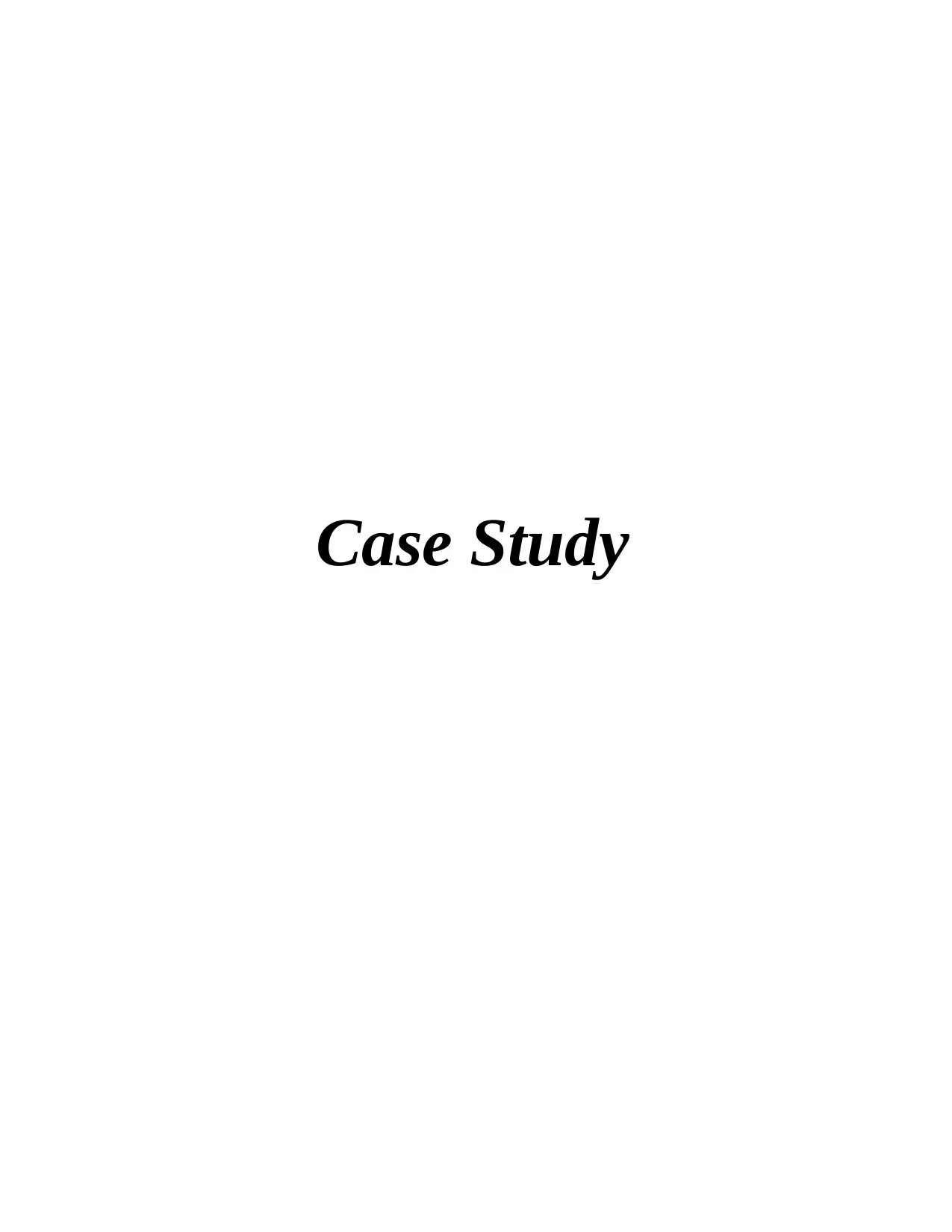
Case Study
Paraphrase This Document
Need a fresh take? Get an instant paraphrase of this document with our AI Paraphraser

Contents
INTRODUCTION.....................................................................................................................................3
MAIN BODY.............................................................................................................................................3
CONCLUSION..........................................................................................................................................7
REFERENCES..........................................................................................................................................8
INTRODUCTION.....................................................................................................................................3
MAIN BODY.............................................................................................................................................3
CONCLUSION..........................................................................................................................................7
REFERENCES..........................................................................................................................................8
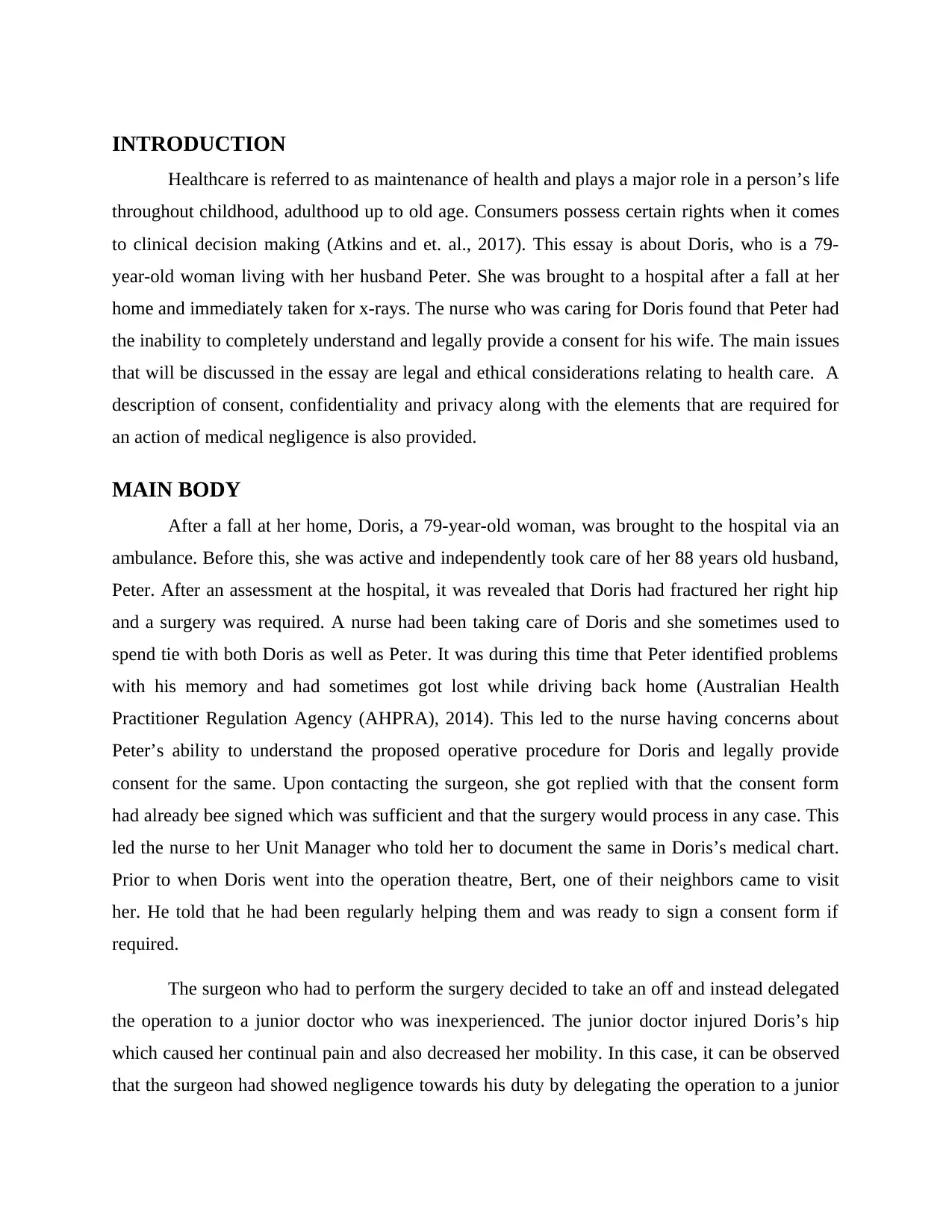
INTRODUCTION
Healthcare is referred to as maintenance of health and plays a major role in a person’s life
throughout childhood, adulthood up to old age. Consumers possess certain rights when it comes
to clinical decision making (Atkins and et. al., 2017). This essay is about Doris, who is a 79-
year-old woman living with her husband Peter. She was brought to a hospital after a fall at her
home and immediately taken for x-rays. The nurse who was caring for Doris found that Peter had
the inability to completely understand and legally provide a consent for his wife. The main issues
that will be discussed in the essay are legal and ethical considerations relating to health care. A
description of consent, confidentiality and privacy along with the elements that are required for
an action of medical negligence is also provided.
MAIN BODY
After a fall at her home, Doris, a 79-year-old woman, was brought to the hospital via an
ambulance. Before this, she was active and independently took care of her 88 years old husband,
Peter. After an assessment at the hospital, it was revealed that Doris had fractured her right hip
and a surgery was required. A nurse had been taking care of Doris and she sometimes used to
spend tie with both Doris as well as Peter. It was during this time that Peter identified problems
with his memory and had sometimes got lost while driving back home (Australian Health
Practitioner Regulation Agency (AHPRA), 2014). This led to the nurse having concerns about
Peter’s ability to understand the proposed operative procedure for Doris and legally provide
consent for the same. Upon contacting the surgeon, she got replied with that the consent form
had already bee signed which was sufficient and that the surgery would process in any case. This
led the nurse to her Unit Manager who told her to document the same in Doris’s medical chart.
Prior to when Doris went into the operation theatre, Bert, one of their neighbors came to visit
her. He told that he had been regularly helping them and was ready to sign a consent form if
required.
The surgeon who had to perform the surgery decided to take an off and instead delegated
the operation to a junior doctor who was inexperienced. The junior doctor injured Doris’s hip
which caused her continual pain and also decreased her mobility. In this case, it can be observed
that the surgeon had showed negligence towards his duty by delegating the operation to a junior
Healthcare is referred to as maintenance of health and plays a major role in a person’s life
throughout childhood, adulthood up to old age. Consumers possess certain rights when it comes
to clinical decision making (Atkins and et. al., 2017). This essay is about Doris, who is a 79-
year-old woman living with her husband Peter. She was brought to a hospital after a fall at her
home and immediately taken for x-rays. The nurse who was caring for Doris found that Peter had
the inability to completely understand and legally provide a consent for his wife. The main issues
that will be discussed in the essay are legal and ethical considerations relating to health care. A
description of consent, confidentiality and privacy along with the elements that are required for
an action of medical negligence is also provided.
MAIN BODY
After a fall at her home, Doris, a 79-year-old woman, was brought to the hospital via an
ambulance. Before this, she was active and independently took care of her 88 years old husband,
Peter. After an assessment at the hospital, it was revealed that Doris had fractured her right hip
and a surgery was required. A nurse had been taking care of Doris and she sometimes used to
spend tie with both Doris as well as Peter. It was during this time that Peter identified problems
with his memory and had sometimes got lost while driving back home (Australian Health
Practitioner Regulation Agency (AHPRA), 2014). This led to the nurse having concerns about
Peter’s ability to understand the proposed operative procedure for Doris and legally provide
consent for the same. Upon contacting the surgeon, she got replied with that the consent form
had already bee signed which was sufficient and that the surgery would process in any case. This
led the nurse to her Unit Manager who told her to document the same in Doris’s medical chart.
Prior to when Doris went into the operation theatre, Bert, one of their neighbors came to visit
her. He told that he had been regularly helping them and was ready to sign a consent form if
required.
The surgeon who had to perform the surgery decided to take an off and instead delegated
the operation to a junior doctor who was inexperienced. The junior doctor injured Doris’s hip
which caused her continual pain and also decreased her mobility. In this case, it can be observed
that the surgeon had showed negligence towards his duty by delegating the operation to a junior
⊘ This is a preview!⊘
Do you want full access?
Subscribe today to unlock all pages.

Trusted by 1+ million students worldwide
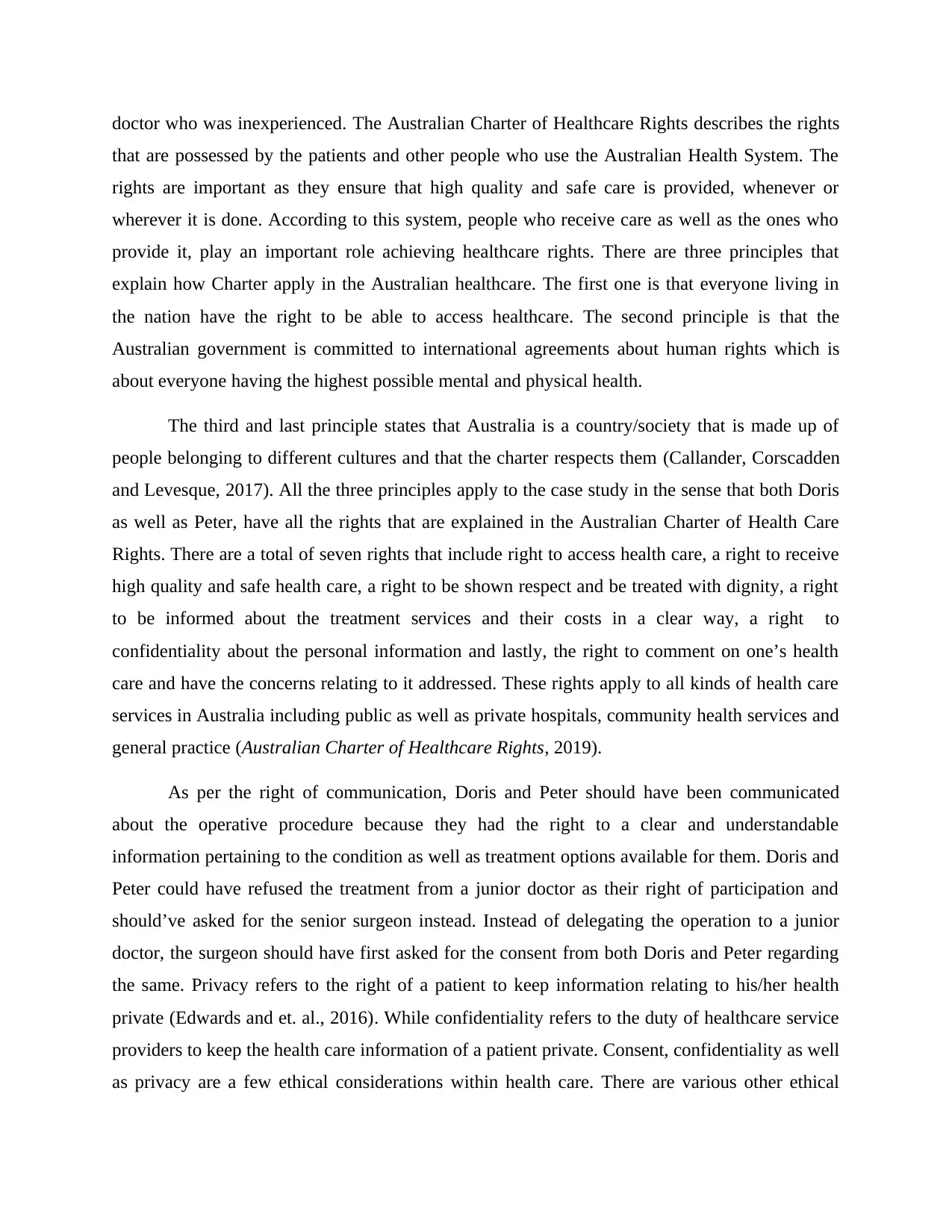
doctor who was inexperienced. The Australian Charter of Healthcare Rights describes the rights
that are possessed by the patients and other people who use the Australian Health System. The
rights are important as they ensure that high quality and safe care is provided, whenever or
wherever it is done. According to this system, people who receive care as well as the ones who
provide it, play an important role achieving healthcare rights. There are three principles that
explain how Charter apply in the Australian healthcare. The first one is that everyone living in
the nation have the right to be able to access healthcare. The second principle is that the
Australian government is committed to international agreements about human rights which is
about everyone having the highest possible mental and physical health.
The third and last principle states that Australia is a country/society that is made up of
people belonging to different cultures and that the charter respects them (Callander, Corscadden
and Levesque, 2017). All the three principles apply to the case study in the sense that both Doris
as well as Peter, have all the rights that are explained in the Australian Charter of Health Care
Rights. There are a total of seven rights that include right to access health care, a right to receive
high quality and safe health care, a right to be shown respect and be treated with dignity, a right
to be informed about the treatment services and their costs in a clear way, a right to
confidentiality about the personal information and lastly, the right to comment on one’s health
care and have the concerns relating to it addressed. These rights apply to all kinds of health care
services in Australia including public as well as private hospitals, community health services and
general practice (Australian Charter of Healthcare Rights, 2019).
As per the right of communication, Doris and Peter should have been communicated
about the operative procedure because they had the right to a clear and understandable
information pertaining to the condition as well as treatment options available for them. Doris and
Peter could have refused the treatment from a junior doctor as their right of participation and
should’ve asked for the senior surgeon instead. Instead of delegating the operation to a junior
doctor, the surgeon should have first asked for the consent from both Doris and Peter regarding
the same. Privacy refers to the right of a patient to keep information relating to his/her health
private (Edwards and et. al., 2016). While confidentiality refers to the duty of healthcare service
providers to keep the health care information of a patient private. Consent, confidentiality as well
as privacy are a few ethical considerations within health care. There are various other ethical
that are possessed by the patients and other people who use the Australian Health System. The
rights are important as they ensure that high quality and safe care is provided, whenever or
wherever it is done. According to this system, people who receive care as well as the ones who
provide it, play an important role achieving healthcare rights. There are three principles that
explain how Charter apply in the Australian healthcare. The first one is that everyone living in
the nation have the right to be able to access healthcare. The second principle is that the
Australian government is committed to international agreements about human rights which is
about everyone having the highest possible mental and physical health.
The third and last principle states that Australia is a country/society that is made up of
people belonging to different cultures and that the charter respects them (Callander, Corscadden
and Levesque, 2017). All the three principles apply to the case study in the sense that both Doris
as well as Peter, have all the rights that are explained in the Australian Charter of Health Care
Rights. There are a total of seven rights that include right to access health care, a right to receive
high quality and safe health care, a right to be shown respect and be treated with dignity, a right
to be informed about the treatment services and their costs in a clear way, a right to
confidentiality about the personal information and lastly, the right to comment on one’s health
care and have the concerns relating to it addressed. These rights apply to all kinds of health care
services in Australia including public as well as private hospitals, community health services and
general practice (Australian Charter of Healthcare Rights, 2019).
As per the right of communication, Doris and Peter should have been communicated
about the operative procedure because they had the right to a clear and understandable
information pertaining to the condition as well as treatment options available for them. Doris and
Peter could have refused the treatment from a junior doctor as their right of participation and
should’ve asked for the senior surgeon instead. Instead of delegating the operation to a junior
doctor, the surgeon should have first asked for the consent from both Doris and Peter regarding
the same. Privacy refers to the right of a patient to keep information relating to his/her health
private (Edwards and et. al., 2016). While confidentiality refers to the duty of healthcare service
providers to keep the health care information of a patient private. Consent, confidentiality as well
as privacy are a few ethical considerations within health care. There are various other ethical
Paraphrase This Document
Need a fresh take? Get an instant paraphrase of this document with our AI Paraphraser
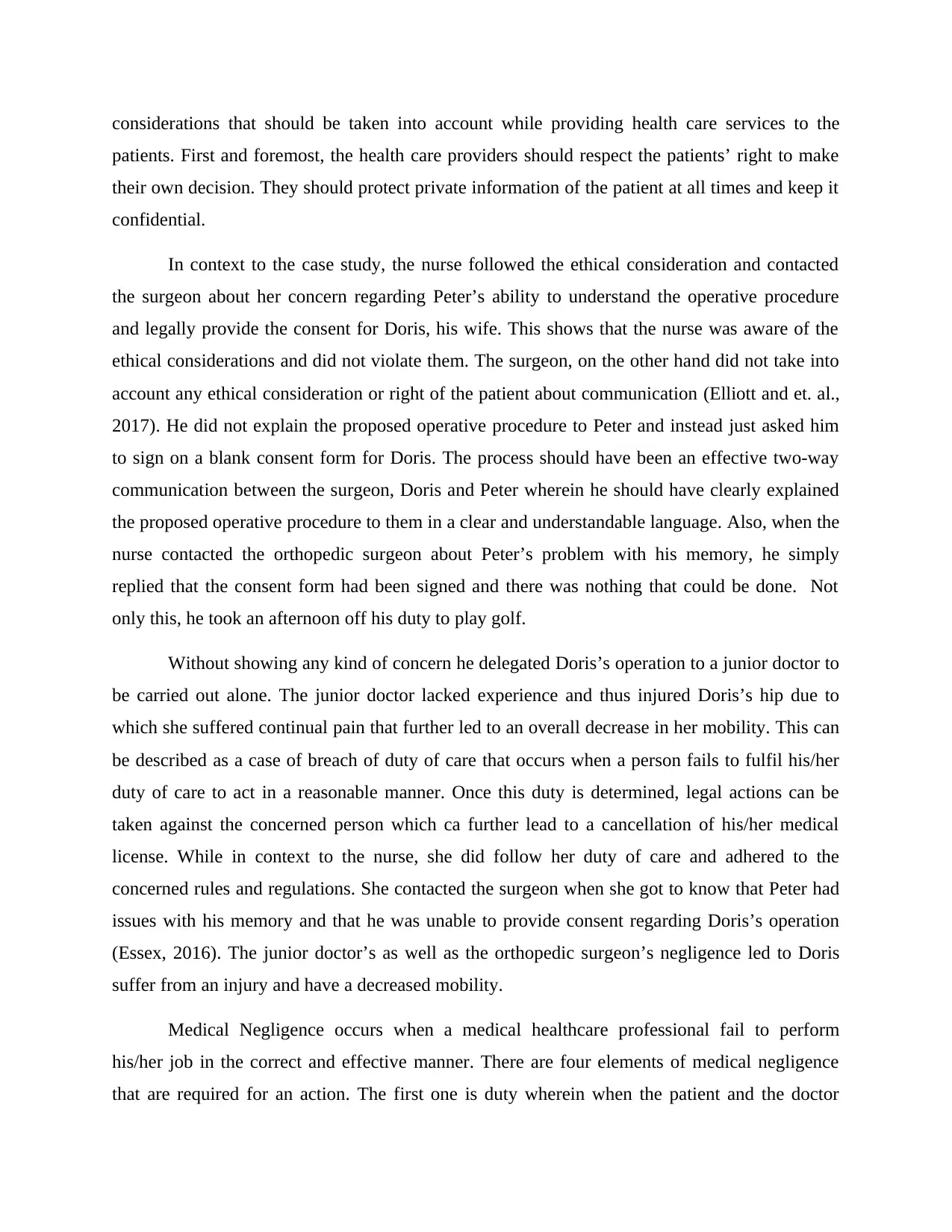
considerations that should be taken into account while providing health care services to the
patients. First and foremost, the health care providers should respect the patients’ right to make
their own decision. They should protect private information of the patient at all times and keep it
confidential.
In context to the case study, the nurse followed the ethical consideration and contacted
the surgeon about her concern regarding Peter’s ability to understand the operative procedure
and legally provide the consent for Doris, his wife. This shows that the nurse was aware of the
ethical considerations and did not violate them. The surgeon, on the other hand did not take into
account any ethical consideration or right of the patient about communication (Elliott and et. al.,
2017). He did not explain the proposed operative procedure to Peter and instead just asked him
to sign on a blank consent form for Doris. The process should have been an effective two-way
communication between the surgeon, Doris and Peter wherein he should have clearly explained
the proposed operative procedure to them in a clear and understandable language. Also, when the
nurse contacted the orthopedic surgeon about Peter’s problem with his memory, he simply
replied that the consent form had been signed and there was nothing that could be done. Not
only this, he took an afternoon off his duty to play golf.
Without showing any kind of concern he delegated Doris’s operation to a junior doctor to
be carried out alone. The junior doctor lacked experience and thus injured Doris’s hip due to
which she suffered continual pain that further led to an overall decrease in her mobility. This can
be described as a case of breach of duty of care that occurs when a person fails to fulfil his/her
duty of care to act in a reasonable manner. Once this duty is determined, legal actions can be
taken against the concerned person which ca further lead to a cancellation of his/her medical
license. While in context to the nurse, she did follow her duty of care and adhered to the
concerned rules and regulations. She contacted the surgeon when she got to know that Peter had
issues with his memory and that he was unable to provide consent regarding Doris’s operation
(Essex, 2016). The junior doctor’s as well as the orthopedic surgeon’s negligence led to Doris
suffer from an injury and have a decreased mobility.
Medical Negligence occurs when a medical healthcare professional fail to perform
his/her job in the correct and effective manner. There are four elements of medical negligence
that are required for an action. The first one is duty wherein when the patient and the doctor
patients. First and foremost, the health care providers should respect the patients’ right to make
their own decision. They should protect private information of the patient at all times and keep it
confidential.
In context to the case study, the nurse followed the ethical consideration and contacted
the surgeon about her concern regarding Peter’s ability to understand the operative procedure
and legally provide the consent for Doris, his wife. This shows that the nurse was aware of the
ethical considerations and did not violate them. The surgeon, on the other hand did not take into
account any ethical consideration or right of the patient about communication (Elliott and et. al.,
2017). He did not explain the proposed operative procedure to Peter and instead just asked him
to sign on a blank consent form for Doris. The process should have been an effective two-way
communication between the surgeon, Doris and Peter wherein he should have clearly explained
the proposed operative procedure to them in a clear and understandable language. Also, when the
nurse contacted the orthopedic surgeon about Peter’s problem with his memory, he simply
replied that the consent form had been signed and there was nothing that could be done. Not
only this, he took an afternoon off his duty to play golf.
Without showing any kind of concern he delegated Doris’s operation to a junior doctor to
be carried out alone. The junior doctor lacked experience and thus injured Doris’s hip due to
which she suffered continual pain that further led to an overall decrease in her mobility. This can
be described as a case of breach of duty of care that occurs when a person fails to fulfil his/her
duty of care to act in a reasonable manner. Once this duty is determined, legal actions can be
taken against the concerned person which ca further lead to a cancellation of his/her medical
license. While in context to the nurse, she did follow her duty of care and adhered to the
concerned rules and regulations. She contacted the surgeon when she got to know that Peter had
issues with his memory and that he was unable to provide consent regarding Doris’s operation
(Essex, 2016). The junior doctor’s as well as the orthopedic surgeon’s negligence led to Doris
suffer from an injury and have a decreased mobility.
Medical Negligence occurs when a medical healthcare professional fail to perform
his/her job in the correct and effective manner. There are four elements of medical negligence
that are required for an action. The first one is duty wherein when the patient and the doctor
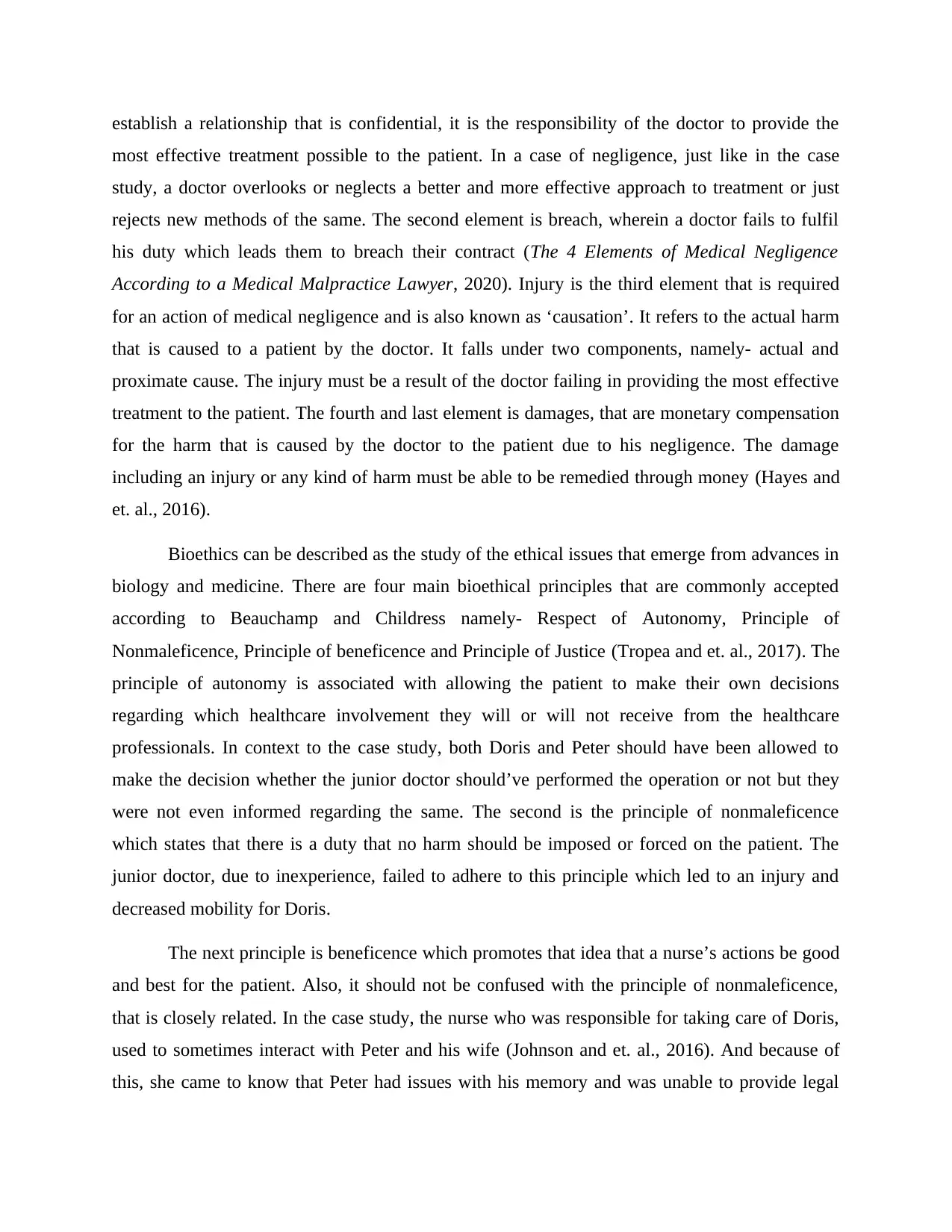
establish a relationship that is confidential, it is the responsibility of the doctor to provide the
most effective treatment possible to the patient. In a case of negligence, just like in the case
study, a doctor overlooks or neglects a better and more effective approach to treatment or just
rejects new methods of the same. The second element is breach, wherein a doctor fails to fulfil
his duty which leads them to breach their contract (The 4 Elements of Medical Negligence
According to a Medical Malpractice Lawyer, 2020). Injury is the third element that is required
for an action of medical negligence and is also known as ‘causation’. It refers to the actual harm
that is caused to a patient by the doctor. It falls under two components, namely- actual and
proximate cause. The injury must be a result of the doctor failing in providing the most effective
treatment to the patient. The fourth and last element is damages, that are monetary compensation
for the harm that is caused by the doctor to the patient due to his negligence. The damage
including an injury or any kind of harm must be able to be remedied through money (Hayes and
et. al., 2016).
Bioethics can be described as the study of the ethical issues that emerge from advances in
biology and medicine. There are four main bioethical principles that are commonly accepted
according to Beauchamp and Childress namely- Respect of Autonomy, Principle of
Nonmaleficence, Principle of beneficence and Principle of Justice (Tropea and et. al., 2017). The
principle of autonomy is associated with allowing the patient to make their own decisions
regarding which healthcare involvement they will or will not receive from the healthcare
professionals. In context to the case study, both Doris and Peter should have been allowed to
make the decision whether the junior doctor should’ve performed the operation or not but they
were not even informed regarding the same. The second is the principle of nonmaleficence
which states that there is a duty that no harm should be imposed or forced on the patient. The
junior doctor, due to inexperience, failed to adhere to this principle which led to an injury and
decreased mobility for Doris.
The next principle is beneficence which promotes that idea that a nurse’s actions be good
and best for the patient. Also, it should not be confused with the principle of nonmaleficence,
that is closely related. In the case study, the nurse who was responsible for taking care of Doris,
used to sometimes interact with Peter and his wife (Johnson and et. al., 2016). And because of
this, she came to know that Peter had issues with his memory and was unable to provide legal
most effective treatment possible to the patient. In a case of negligence, just like in the case
study, a doctor overlooks or neglects a better and more effective approach to treatment or just
rejects new methods of the same. The second element is breach, wherein a doctor fails to fulfil
his duty which leads them to breach their contract (The 4 Elements of Medical Negligence
According to a Medical Malpractice Lawyer, 2020). Injury is the third element that is required
for an action of medical negligence and is also known as ‘causation’. It refers to the actual harm
that is caused to a patient by the doctor. It falls under two components, namely- actual and
proximate cause. The injury must be a result of the doctor failing in providing the most effective
treatment to the patient. The fourth and last element is damages, that are monetary compensation
for the harm that is caused by the doctor to the patient due to his negligence. The damage
including an injury or any kind of harm must be able to be remedied through money (Hayes and
et. al., 2016).
Bioethics can be described as the study of the ethical issues that emerge from advances in
biology and medicine. There are four main bioethical principles that are commonly accepted
according to Beauchamp and Childress namely- Respect of Autonomy, Principle of
Nonmaleficence, Principle of beneficence and Principle of Justice (Tropea and et. al., 2017). The
principle of autonomy is associated with allowing the patient to make their own decisions
regarding which healthcare involvement they will or will not receive from the healthcare
professionals. In context to the case study, both Doris and Peter should have been allowed to
make the decision whether the junior doctor should’ve performed the operation or not but they
were not even informed regarding the same. The second is the principle of nonmaleficence
which states that there is a duty that no harm should be imposed or forced on the patient. The
junior doctor, due to inexperience, failed to adhere to this principle which led to an injury and
decreased mobility for Doris.
The next principle is beneficence which promotes that idea that a nurse’s actions be good
and best for the patient. Also, it should not be confused with the principle of nonmaleficence,
that is closely related. In the case study, the nurse who was responsible for taking care of Doris,
used to sometimes interact with Peter and his wife (Johnson and et. al., 2016). And because of
this, she came to know that Peter had issues with his memory and was unable to provide legal
⊘ This is a preview!⊘
Do you want full access?
Subscribe today to unlock all pages.

Trusted by 1+ million students worldwide
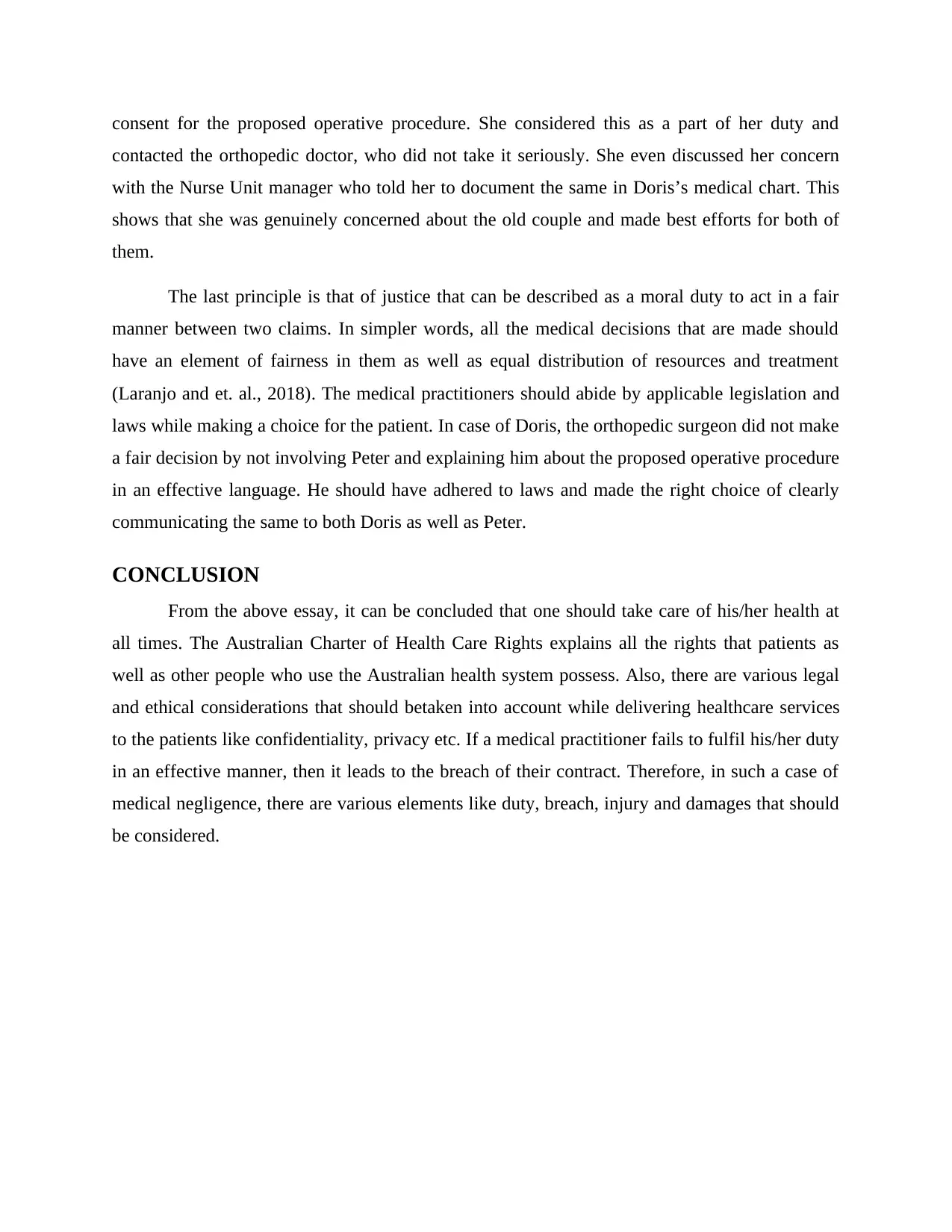
consent for the proposed operative procedure. She considered this as a part of her duty and
contacted the orthopedic doctor, who did not take it seriously. She even discussed her concern
with the Nurse Unit manager who told her to document the same in Doris’s medical chart. This
shows that she was genuinely concerned about the old couple and made best efforts for both of
them.
The last principle is that of justice that can be described as a moral duty to act in a fair
manner between two claims. In simpler words, all the medical decisions that are made should
have an element of fairness in them as well as equal distribution of resources and treatment
(Laranjo and et. al., 2018). The medical practitioners should abide by applicable legislation and
laws while making a choice for the patient. In case of Doris, the orthopedic surgeon did not make
a fair decision by not involving Peter and explaining him about the proposed operative procedure
in an effective language. He should have adhered to laws and made the right choice of clearly
communicating the same to both Doris as well as Peter.
CONCLUSION
From the above essay, it can be concluded that one should take care of his/her health at
all times. The Australian Charter of Health Care Rights explains all the rights that patients as
well as other people who use the Australian health system possess. Also, there are various legal
and ethical considerations that should betaken into account while delivering healthcare services
to the patients like confidentiality, privacy etc. If a medical practitioner fails to fulfil his/her duty
in an effective manner, then it leads to the breach of their contract. Therefore, in such a case of
medical negligence, there are various elements like duty, breach, injury and damages that should
be considered.
contacted the orthopedic doctor, who did not take it seriously. She even discussed her concern
with the Nurse Unit manager who told her to document the same in Doris’s medical chart. This
shows that she was genuinely concerned about the old couple and made best efforts for both of
them.
The last principle is that of justice that can be described as a moral duty to act in a fair
manner between two claims. In simpler words, all the medical decisions that are made should
have an element of fairness in them as well as equal distribution of resources and treatment
(Laranjo and et. al., 2018). The medical practitioners should abide by applicable legislation and
laws while making a choice for the patient. In case of Doris, the orthopedic surgeon did not make
a fair decision by not involving Peter and explaining him about the proposed operative procedure
in an effective language. He should have adhered to laws and made the right choice of clearly
communicating the same to both Doris as well as Peter.
CONCLUSION
From the above essay, it can be concluded that one should take care of his/her health at
all times. The Australian Charter of Health Care Rights explains all the rights that patients as
well as other people who use the Australian health system possess. Also, there are various legal
and ethical considerations that should betaken into account while delivering healthcare services
to the patients like confidentiality, privacy etc. If a medical practitioner fails to fulfil his/her duty
in an effective manner, then it leads to the breach of their contract. Therefore, in such a case of
medical negligence, there are various elements like duty, breach, injury and damages that should
be considered.
Paraphrase This Document
Need a fresh take? Get an instant paraphrase of this document with our AI Paraphraser
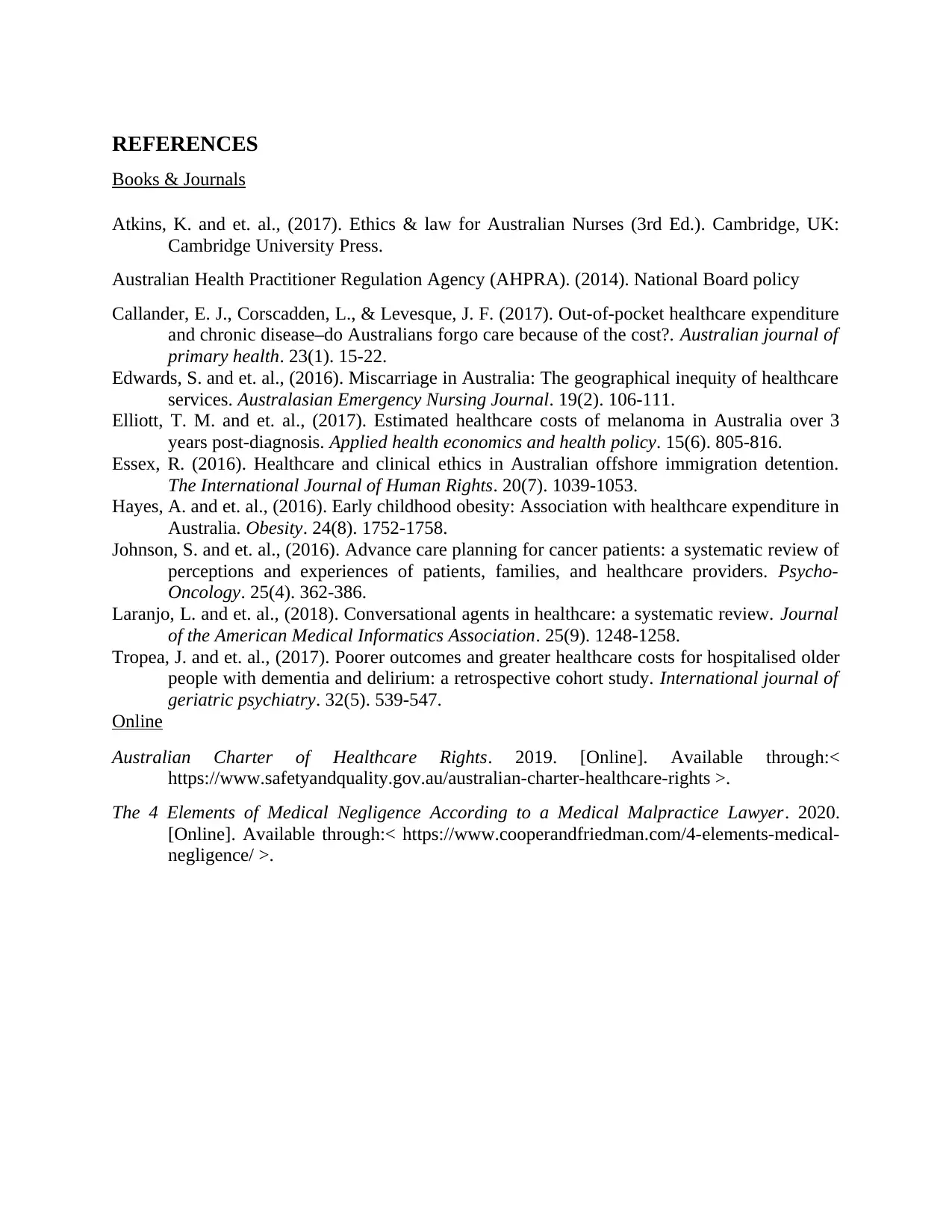
REFERENCES
Books & Journals
Atkins, K. and et. al., (2017). Ethics & law for Australian Nurses (3rd Ed.). Cambridge, UK:
Cambridge University Press.
Australian Health Practitioner Regulation Agency (AHPRA). (2014). National Board policy
Callander, E. J., Corscadden, L., & Levesque, J. F. (2017). Out-of-pocket healthcare expenditure
and chronic disease–do Australians forgo care because of the cost?. Australian journal of
primary health. 23(1). 15-22.
Edwards, S. and et. al., (2016). Miscarriage in Australia: The geographical inequity of healthcare
services. Australasian Emergency Nursing Journal. 19(2). 106-111.
Elliott, T. M. and et. al., (2017). Estimated healthcare costs of melanoma in Australia over 3
years post-diagnosis. Applied health economics and health policy. 15(6). 805-816.
Essex, R. (2016). Healthcare and clinical ethics in Australian offshore immigration detention.
The International Journal of Human Rights. 20(7). 1039-1053.
Hayes, A. and et. al., (2016). Early childhood obesity: Association with healthcare expenditure in
Australia. Obesity. 24(8). 1752-1758.
Johnson, S. and et. al., (2016). Advance care planning for cancer patients: a systematic review of
perceptions and experiences of patients, families, and healthcare providers. Psycho‐
Oncology. 25(4). 362-386.
Laranjo, L. and et. al., (2018). Conversational agents in healthcare: a systematic review. Journal
of the American Medical Informatics Association. 25(9). 1248-1258.
Tropea, J. and et. al., (2017). Poorer outcomes and greater healthcare costs for hospitalised older
people with dementia and delirium: a retrospective cohort study. International journal of
geriatric psychiatry. 32(5). 539-547.
Online
Australian Charter of Healthcare Rights. 2019. [Online]. Available through:<
https://www.safetyandquality.gov.au/australian-charter-healthcare-rights >.
The 4 Elements of Medical Negligence According to a Medical Malpractice Lawyer. 2020.
[Online]. Available through:< https://www.cooperandfriedman.com/4-elements-medical-
negligence/ >.
Books & Journals
Atkins, K. and et. al., (2017). Ethics & law for Australian Nurses (3rd Ed.). Cambridge, UK:
Cambridge University Press.
Australian Health Practitioner Regulation Agency (AHPRA). (2014). National Board policy
Callander, E. J., Corscadden, L., & Levesque, J. F. (2017). Out-of-pocket healthcare expenditure
and chronic disease–do Australians forgo care because of the cost?. Australian journal of
primary health. 23(1). 15-22.
Edwards, S. and et. al., (2016). Miscarriage in Australia: The geographical inequity of healthcare
services. Australasian Emergency Nursing Journal. 19(2). 106-111.
Elliott, T. M. and et. al., (2017). Estimated healthcare costs of melanoma in Australia over 3
years post-diagnosis. Applied health economics and health policy. 15(6). 805-816.
Essex, R. (2016). Healthcare and clinical ethics in Australian offshore immigration detention.
The International Journal of Human Rights. 20(7). 1039-1053.
Hayes, A. and et. al., (2016). Early childhood obesity: Association with healthcare expenditure in
Australia. Obesity. 24(8). 1752-1758.
Johnson, S. and et. al., (2016). Advance care planning for cancer patients: a systematic review of
perceptions and experiences of patients, families, and healthcare providers. Psycho‐
Oncology. 25(4). 362-386.
Laranjo, L. and et. al., (2018). Conversational agents in healthcare: a systematic review. Journal
of the American Medical Informatics Association. 25(9). 1248-1258.
Tropea, J. and et. al., (2017). Poorer outcomes and greater healthcare costs for hospitalised older
people with dementia and delirium: a retrospective cohort study. International journal of
geriatric psychiatry. 32(5). 539-547.
Online
Australian Charter of Healthcare Rights. 2019. [Online]. Available through:<
https://www.safetyandquality.gov.au/australian-charter-healthcare-rights >.
The 4 Elements of Medical Negligence According to a Medical Malpractice Lawyer. 2020.
[Online]. Available through:< https://www.cooperandfriedman.com/4-elements-medical-
negligence/ >.
1 out of 8
Related Documents
Your All-in-One AI-Powered Toolkit for Academic Success.
+13062052269
info@desklib.com
Available 24*7 on WhatsApp / Email
![[object Object]](/_next/static/media/star-bottom.7253800d.svg)
Unlock your academic potential
Copyright © 2020–2025 A2Z Services. All Rights Reserved. Developed and managed by ZUCOL.





